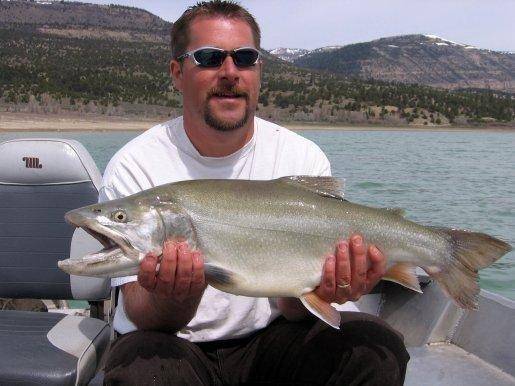Are you looking for a unique trout-fishing experience? One that could result in your pole almost being snapped in half by a big splake? If so, make a trip soon to Joes Valley Reservoir.
Located about 15 miles west of Orangeville, Joes Valley is home to four predators — splake, tiger trout, cutthroat trout and tiger muskie. Not only are the fish in the reservoir unique, what happens at the reservoir in the spring is unique too — you can catch big splake right from the shore. “In the spring,” says Justin Hart, “you don’t need a boat or special equipment to nail the big ones.”
In addition to being an avid Joes Valley angler, Hart serves as a regional assistant fisheries manager for the Division of Wildlife Resources.
Hart, who has hooked his share of trophy splake, has had some of his best luck just after the ice has left the reservoir. Several of his largest splake have been caught just a few feet from the bank.
Hart says in the spring, large, predatory trout cruise the shoreline searching for chubs, their main prey source at Joes Valley. “In spring, chubs congregate in a narrow band of warm, shallow water near the shore,” he says. “When they congregate in this narrow band, they become vulnerable to the splake.”
And the splake, in turn, become vulnerable to anglers.
Hart offers several recommendations for those seeking a big splake, a cross between a male brook trout and a female lake trout, at Joes Valley.
- Best Bait
“The best bait, hands down, is chub meat,” Hart says. “It can’t be beat. Bait-casters can’t go wrong with chub meat on the end of their line.” Instead of casting straight out, Hart says bank anglers should cast at an angle, and then bounce their bait back home. From a boat, pitch the meat close to shore, and walk it back to your boat.
For that special touch, use a two- to three-inch curly tail grub on a 1/8- or ¼-ounce jighead, and tip the hook with chub. “Chub meat is hard for the splake to resist,” Hart says.
Hart says for most water conditions, the best jig color is pumpkin brown. In low light or colored water, use something brighter — like chartreuse or white.
- Trolling
Trolling is also a good way to take trophy trout. Last spring, DWR Maintenance Specialist Duane Swasey hooked a nine-pound splake with a fat-lipped Wally Diver while trolling along the reservoir’s east side. As a general rule, long, skinny crankbaits of many makes and models will put trout in your creel. Especially good are minnow-imitating cranks with a gray-over-white color scheme.
Hart says several lures offer better-than-average success. “The best by far is the Jakes Spin-a-Lure,” he says. “Bring along silver and gold. The next best is a Kastmaster in silver and gold.”
- Fishing secrets
When asked for his Joes Valley fishing secrets, DWR Fisheries Biologist Dan Keller offered a slightly different twist. “I’ve caught most of my trout on a three-inch Berkley Gulp in watermelon or smelt color,” Keller says.
Keller tips a darter-style lead head jig with Gulp and goes hunting. With his fish finder, he locks onto underwater topography, which stair-steps from the shallow shoreline into the deep. He then bounces his jig from one ledge to the next until he tricks one of the predatory trout that are waiting in ambush just off the edge of a shelf.
- Best spots
Anglers who know their way around Joes Valley Reservoir have their own honey holes:
– Hart likes to fish the mouths of tributaries, such as Seely
Creek and Lowry Water. He’s hooked some big fish in these areas.
– Keller and Swasey prefer trolling or still-fishing under the
cliffs that line the bank south of the dam.
– Shoreline anglers are split.В Some prefer the stretch of rocky
shoreline on the east side, from the dam to the boat ramp.В West-side anglers fish the points around the marina.
- Regulations
Joes Valley Reservoir has special regulations:
– Tiger muskies less than 40 inches long must be returned to the water immediately. “By next year,” Hart says, “a chub-rich diet will turn these toothy torpedoes into some great fighters and table fare.”
– The trout limit is four.В Only one of the four trout may be over 18 inches long, though. The 18-inch restriction keeps more trophy trout in the pond. It also allows the trout to wreak havoc on the chubs, which have been a bane to anglers since someone illegally introduced chubs to the reservoir.
- Parting thoughts
Hart says if you’re looking for a chance to hook a big trout, you should give Joes Valley a try. Fishing at ice-off is a limited, once-a-year engagement.
“There’s no guarantee you’ll hook a trophy trout,” he says, “but staying home is a guarantee that you won’t. Grab your pole, your reel and your favorite tackle. Few fishing destinations offer as much scenic beauty in a setting designed for the recluse [who has] a love affair with the out-of-doors. Hooking that big one is just the icing on the cake.”

